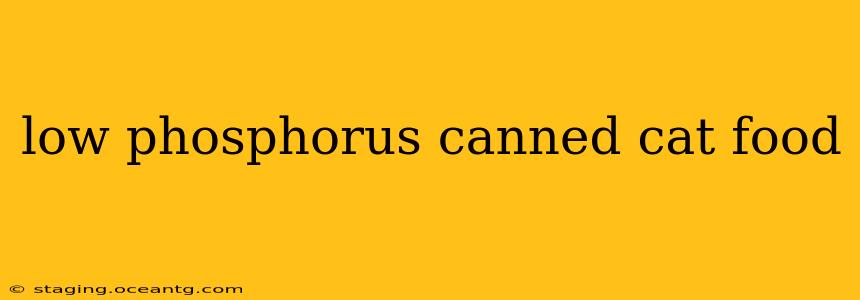Chronic kidney disease (CKD) is a prevalent and serious condition in cats, often requiring a specialized diet low in phosphorus. Finding the right low-phosphorus canned cat food can be daunting, but understanding the nuances of ingredients and nutritional needs is crucial for your feline friend's well-being. This guide will help you navigate the world of low-phosphorus cat food, providing the information you need to make informed choices.
What is Phosphorus and Why is it Important for Cats?
Phosphorus is an essential mineral playing a vital role in numerous bodily functions, including bone health, energy production, and nerve function. However, cats with CKD often struggle to process phosphorus efficiently, leading to a buildup in the bloodstream. This excess phosphorus can worsen kidney damage and accelerate disease progression. Therefore, a diet restricted in phosphorus is a cornerstone of managing feline CKD.
How Much Phosphorus is Too Much in Cat Food?
The ideal phosphorus level in cat food for cats with CKD is generally considered to be below 0.3% to 0.4% on a dry matter basis. Always check the guaranteed analysis on the can or package; it will list the minimum and maximum percentages of phosphorus. Remember that dry matter percentages are crucial – canned food has a high moisture content, making direct comparisons between wet and dry food phosphorus levels challenging. Don't hesitate to consult your veterinarian for personalized recommendations based on your cat's specific needs and stage of CKD.
What are the Best Sources of Low-Phosphorus Canned Cat Food?
Unfortunately, there isn't a single "best" brand, as individual cats have unique dietary needs and preferences. The market offers various brands specifically formulated for renal (kidney) support. Look for labels explicitly stating "renal diet," "low phosphorus," or "low protein" (often a necessary component of CKD management). Always check the guaranteed analysis to confirm the phosphorus levels are within the recommended range for your cat. Your veterinarian is the best resource to determine the most appropriate brand for your cat's condition and overall health.
H2: What are the key ingredients to look for in low-phosphorus cat food?
High-quality protein sources are essential, even in low-phosphorus diets. Look for foods featuring easily digestible proteins like chicken, turkey, or fish. Avoid ingredients known for higher phosphorus content, such as organ meats (liver, kidney). Many low-phosphorus diets also incorporate ingredients that help bind phosphorus in the digestive tract, promoting better absorption.
H2: Can I make my own low-phosphorus cat food?
While some pet owners opt for homemade diets, this requires extensive knowledge of feline nutritional requirements and careful monitoring to ensure your cat receives the necessary nutrients. Improperly balanced homemade diets can be harmful. It's strongly recommended to consult a veterinary nutritionist if you consider this option, as they can help you create a safe and effective recipe tailored to your cat's specific needs.
H2: My cat refuses to eat low-phosphorus cat food. What can I do?
Changing a cat's diet can be challenging. Introduce the new food gradually, mixing small amounts with their current food and slowly increasing the proportion of the low-phosphorus food over several days. Experiment with different flavors and textures to find something your cat will accept. If your cat continues to refuse the food, consult your veterinarian, who might suggest ways to improve palatability or explore alternative feeding options.
H2: How often should I check my cat's phosphorus levels?
Regular bloodwork is essential to monitor phosphorus levels and the overall effectiveness of the diet. Your veterinarian will advise on the frequency of testing based on your cat's condition and response to treatment. Early detection of any imbalances allows for prompt adjustments to the diet or medication plan.
Conclusion
Choosing the right low-phosphorus canned cat food is crucial for managing CKD. By carefully reviewing labels, understanding the importance of guaranteed analysis, and consulting your veterinarian, you can provide your cat with the best possible nutrition to support their health and well-being. Remember, consistency and monitoring are key to successful management of CKD in cats.
